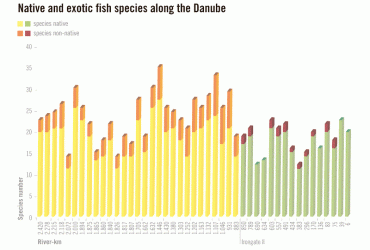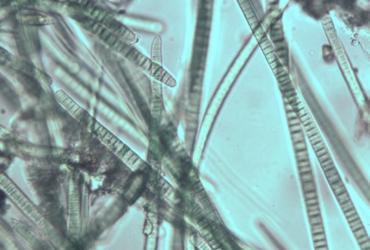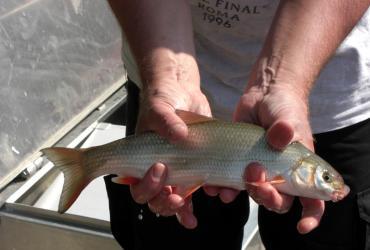The analysis of macroinvertebrates (aquatic insects, worms, clams, snails and other animals without backbones that can be determined without the aid of a microscope and that live in or on sediments) indicated good biological water quality for almost 80% of the Danube sites. Significant organic pollution affecting living organisms was detected in the tributaries Sio, Jantra and Rusenski Lom. Due to excessive pollution, the Arges River did not host any macroinvertebrates.
The fish survey, the first ever for the entire length of the Danube, revealed that only about one-third of the investigated sites on the Danube indicated good status. Hydromorphological alterations are the main pressure on fish populations in the Upper Danube, while water quality is a key pressure in the Middle and the Lower Danube. The lack of migratory species in the Danube indicates a loss of river connectivity.
In the regulated, non-impounded stretches of the Danube, macrophytes (plants, either free-floating or attached to a surface, that can be determined without the need for a microscope) often meet the conditions for good ecological status. However, the situation is unsatisfactory in the impounded stretches upstream from hydro-electric power plants.
The analysis of phytoplankton (plants, mainly microscopic, existing in water bodies) found most of the Danube with acceptable conditions. Elevated levels of chlorophyll-a (an indicator of phytoplankton) and phytoplankton biomass were found only in the Middle reach.
Phytobenthos, (microscopic plants such as algae that live in the bottom layers of the river), in contrast to aquatic fauna, reacts directly to the nutrient content (mostly phosphorus) in the river, and is considered to be a reliable indicator of long-term eutrophication processes. The indication of ecological status, based on the phytobenthos analysis, suggested an increase of nutrients in the longitudinal profile of the Danube.
One-third of the sites were affected by microbial contamination, while faecal indicators (excreted by humans and warm-blooded animals) originated mainly from human sewage. Identified hot-spots were the Danube stretch between Budapest and Belgrade and the tributaries Arges and Rusenski Lom.
Can people swim in the Danube River Basin?
Yes, but not everywhere.
For more detailed results from the JDS2, please download our JDS2 Publications.



















